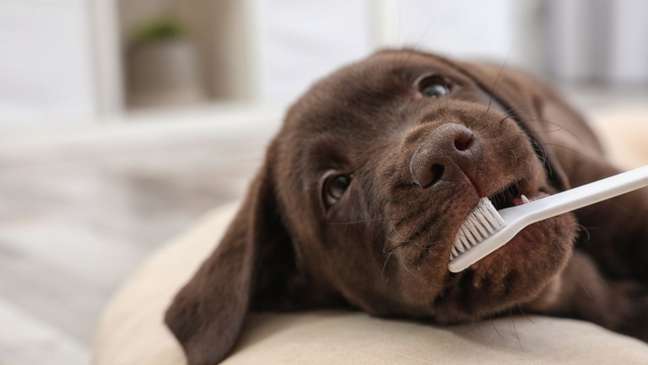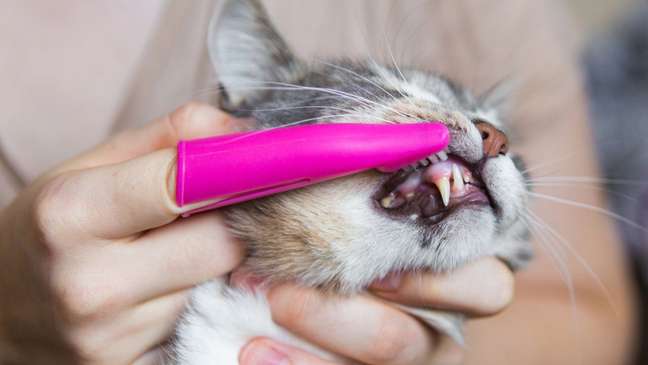Did you feel that “breath” on your dog or cat? This could be a sign of periodontal disease; Check out pet hygiene care tips

October 25 is marked by the national campaign for oral health and, although it is a human-oriented topic, animal mouth hygiene also deserves attention. This because, Dogs and cats often suffer from periodontal diseasewhich cause bad breath in pets and other serious harm.
According to veterinary Franciele Fraiz, this problem affects more than 80% of adult pets, impacting the teeth, gums, bones and other important mouth structures of pets. “In addition to the inflammatory process of oral diseases which is painful for pets, as the animal’s body works to fight the infection, substances called immune complexes are produced, which are deposited in the kidneys. increasing the chances of developing kidney disease“.
The specialist also explains that the inflammation generated allows the bacteria enter the bloodstream and settle in other organs, causing or worsening diseases such as bronchitis, arthritis and endocarditis. To prevent problems like this from affecting pets, Franciele leaves four important tips. Check it out below!

1. Brush your pet’s teeth regularly
According to the vet, tooth brushing should be done daily or at least three times a week. This prevents the buildup of tartar-forming bacteria – or tartar, as they are popularly known – and periodontal disease. This is a process that begins to occur between 24 and 32 hours after eating food. In other words, brushing is essential!
Nonetheless, not all pets agree to brush their teeth with tranquility. Therefore, the ideal is for this process to start with a puppy to get used to from an early age. Franciele explains that “the first attempts can be made with a damp gauze or with your fingers, until the animal gets used to it. Then you can introduce the toothbrush, suitable for the size of the animal, into the routine”.
Now, if the dog or cat is already an adult, the tip is linking oral hygiene to positive rewards. The animal therefore associates the moment of brushing with walks, games, praise or caresses and, consequently, can tolerate hygiene with more tranquility.
2. Use specific products for pets
Although the habit is similar to that of humans, brushing teeth in pets requires specific products for them. “There are pet-specific toothpastes that, in addition to being safe for them, can be manipulated with attractive flavors, such as chicken, bacon, banana, among others,” recommends the vet.
3. Snacks, toys and sprays are welcome!
In addition to brushing, there are other possibilities of products that help with oral hygiene, such as snacks for this purpose, toys that stimulate the bite, sprays and foams for the mouth with actives for hygiene and prevention of halitosis in animals. domestic. These are options to help in the daily life of cats and dogs.
There are still other products aimed at the oral hygiene of pets, as Franciele explains. “In veterinary handling it is possible to prepare mousses, oral films and wipes moistened with drugs suitable for each pet and with the flavor they prefer. However, it should be used in addition to brushingbecause it is only able to remove food residues and bacterial biofilms that are deposited daily on the surface of teeth and gums “, specifies the veterinarian.
4. Veterinary monitoring is essential
Just like humans need to go to the dentist regularly, pets should also take care of their oral health with specialists. In the end, this is as important a step as vaccination and ectoparasite control.
In fact, it is these visits to the vet that can identify the first signs of periodontal disease, as its symptoms are discreet and it may take the owner a little longer to realize that something is wrong with the animal.
When bacterial plaque is installed, a surgical procedure for removal, as well as restoring gum depth and extracting compromised teeth. Daily care for pets undergoing the procedure remains the same.
“Surgical removal will correct the damage previously caused, but the accumulation of bacterial biofilm occurs on a daily basis. And it is worth remembering that the oral hygiene routine does not negate the need for periodic visits to the vet or the possibility of a new intervention, as some do. pets have a greater tendency to bacterial plaque and periodontal disease, “concludes the veterinarian.
Source: Franciele Fraiz, veterinary at DrogaVET, a veterinary handling pharmacy chain.
+The best content in your email for free. Choose your favorite Earth Newsletter. Click here!
Source: Terra
Benjamin Smith is a fashion journalist and author at Gossipify, known for his coverage of the latest fashion trends and industry insights. He writes about clothing, shoes, accessories, and runway shows, providing in-depth analysis and unique perspectives. He’s respected for his ability to spot emerging designers and trends, and for providing practical fashion advice to readers.



-1jyajqq3d5lya.jpg)



